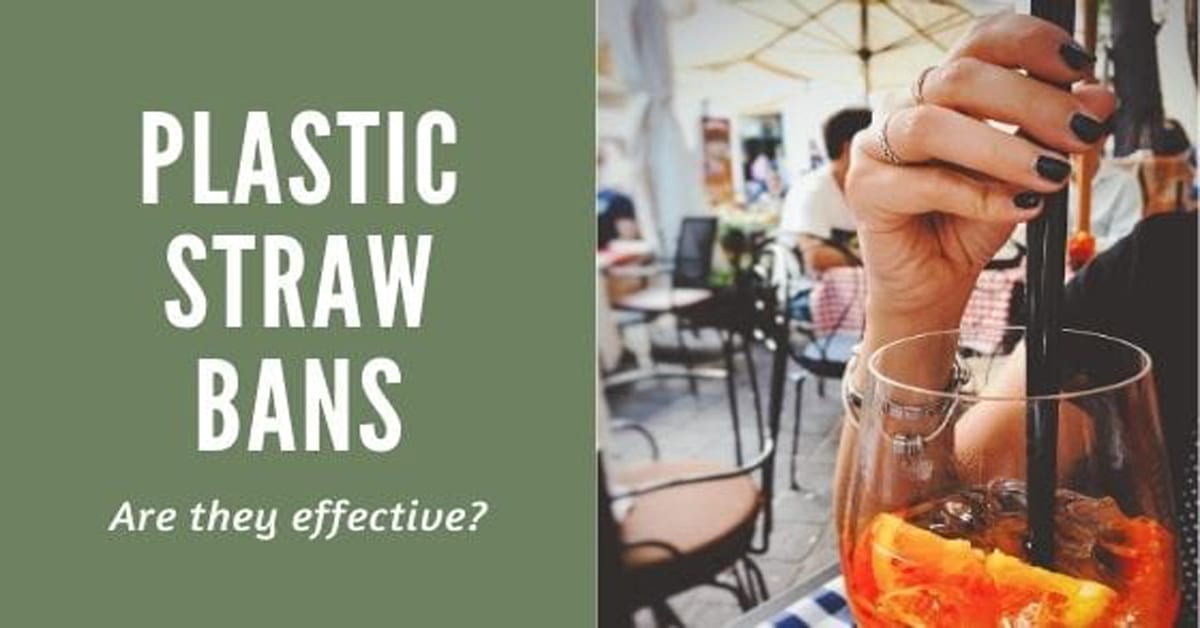Plastic has been a problem. The danger it brings is no secret anymore to everyone. There are many articles, studies and evidences have been written on how it affects the environment negatively. In fact, plastics that reached the ocean have created patches which caused disruptions both on the biodiversity and food chain of the marine animal. For example, the consumption of micro plastics of marine lives resulted to problems or even death to them, which later on, can result to harmful effects on humans too.

Given this, the government, organizations, communities and individual are looking for ways to address this problem on plastic wastes. Aiming to reduce plastic wastes and to clean polluted body of waters are some of the driving forces on passing legislation that will make the said aims a reality.
One of the ideas born out of the issues on plastic are plastic straw bans. The effectiveness of these plastic straw bans will be examined in this article with the hope to shed some light of whether or not the plastic straw bans are effective.
The Plastic Straw as Part of Waste Pollution
Plastic is commonly used everywhere. It can be seen almost everywhere on Earth. Plastic is not only visible on land areas but also in bodies of water. It is so popular that wherever you go, it becomes a common term of everyone.
Plastic is a common term use to describe synthetic or semi-synthetic materials that is applicable to almost anything such as plastic containers for food packaging and cosmetics as well as other materials depending on the purpose and usage. Since 1950, the production of plastic surpassed other materials. The surge in plastic production is caused by in demand usage as alternative for packaging such as replacement for glass. Plastic is being patronized because it is convenient, durable and cheaper than other products. It is lightweight, hygienic and resistant. It is designed to be thrown away. Because it is disposable, people are throwing it incessantly.
However, disposable plastics ironically are not decomposing regularly in the environment compared to papers and leaves. Plastic photodegrades into tiny pieces (such as micro plastics) which is difficult to treat or to collect. According to Pollution Solutions, “Photodegradation is the process by which a substance is altered via photons, especially those found in the wavelengths of the sun’s rays. Though photodegradation does eventually degrade plastic, this is a very slow and inefficient process.” Thus, it ends piling up and polluting both land and bodies of water.
In the report of the United Nations Environment Program, out of 9 Billion tons of plastic had produced around the world only 9 percent of it has been recycled and it is expected that by 2050 there will be around 12 Billion tons of plastic litters in landfills and the environment.
Part of this plastic pollution is the plastic straw. Plastic straw are used for sipping drinks like soda and milk tea. It is made of polystyrene, polypropylene, and polyethylene. Since, straws are lighter – easily brought by the wind and finally reaching the bodies of water as well as difficult to recycle becoming it as one of the top contributors to plastic pollution contaminating ocean as well as other bodies of water.
According to Freedonia Group, there are 390 million plastic straws roughly used in a day. For instance, imagine if the 10% would end up in the ocean that would be 36 million of plastic straws are ending up in the ocean a day! 36 million is a pretty big number of plastic. In fact in the study conducted by Denise Hardesty and Chris Wilcox, the amount of plastic straws that can be found around the coastlines around the world is approximately 4. 37 Million to 8. 3 Billion, and the large portion of this are coming from the United States. In another, report it is accounted that out of 9 million tons of plastic, 4 percent of it is plastic straws. And the plastic straw production needed large amount of oil and gas extraction utilize in plastic plant production, which can contribute also to the carbon footprint.
Plastic straw is also part of the top 10 most found plastic during International Coastal Cleanup (ICC). In the report of Ocean Conservancy, it shows that in 2016, straws and stirrers land in top seven with 409, 087 while 2017 it stayed in the same spot however it increased in number having the amount of 643, 562. In 2018, it went up drastically reaching the top 3 with the amount of 3, 668, 871 of plastic straws and stirrers. Even if the plastics straws are only 4 percent of the plastic ways seeing the number listed by the Ocean Conservancy is not a small portion.
Plastic straws become one of the top ten of the most found plastics in coastal area is causing hazards to marine life. It affects great numbers of marine lives that resulting to different problems such as death. In accordance to One Green planet, around 100, 000 marine animals such as fishes and sea turtles and over 1, 000, 000 marine birds die from plastic consumption annually. The conservwturtles.org also reported that “many sea turtles suffer from the bubble butts that sea turtles float as a result of trap gas caused by harmful decomposition of marine debris in turtles’ body”.
The ingestion of plastic straw can cause fatal damage to marine life that may cause a decrease in their population affecting the biodiversity of such area. A report in 2015, a species of sea turtle, an Olive Ridlyn, was found with a four-inch plastic straw lodged in its nasal cavity which caused difficulty of breathing as well as in the sense of smelling. Plastic straws like this may entirely stay intact even after two years. Indeed, its decomposition takes longer time.
How do plastic straw bans work?
The plastic straw implementation may vary on different areas, places or countries. However, they also have similarities. Few similarities are listed below.
- Plastic straw bans are prohibiting full service restaurants or fast food chains from providing single-use plastic straws as stated by the law or ordinance. However, there also exemption, if the customer requested for plastic straw, then he or she shall be provided. But, it is highly recommended and encourage that customer should bring his or her own reusable straw.
- Imposition of punishment as stipulated by the law. The punishment may be done by paying for the fine as provided by the law or do a community service in certain agency. Another is temporary closure of the establishment that is proven to violate the law, or may face suit and arrest due to the violation done.
- Plastic straw bans also have a way of rewarding the establishment or businesses that follow the said implementation in a form of citation or award.
- Plastic straw bans foster coordination among various organizations, sectors and agencies to address the issue. For instance, how would be the collection of wastes and implementation should be done and what are the steps that can help in addressing the issue during the implementation.
- Plastic straw bans also provide seminar and talks regarding solid waste management to help people to be aware of the issue and why such policy is being implemented.
The impact of plastic straw bans can be best implemented if the community will also engage. Raising the awareness of the community as well as individuals can help identify what really works best to advance such implementation. Also cooperation among government agencies, non-government organizations and businesses can create opportunities and ways how to manage wastes and create sustainable alternatives. Because in implementing this kind of ban requires massive consultation to be able to resolve hidden issues with the help of key stakeholders such as customers and owners of businesses.
Further, implementation of such policies requires good governance that would foresee the proper implementation considering the complexity of such bans. There must be an observation of change of behavior to be able to see what must need to be reinforced such as whether offering as incentive or discount to people would encourage them to exert effort and follow the implementation.
Where are the plastic straw bans implemented?
Countries around the world are trying their best to apply policies that banning single-use plastics all of these are aiming to address the concerns pose by plastic pollution. So, here are five examples of countries that have plastic straw bans in their cities or other parts of them.
Antigua and Barbuda
Antigua and Barbuda is an island sovereign state in the West Indies in the Americas, lying between the Caribbean Sea and the Atlantic Ocean. It consists of two major islands, Antigua and Barbuda (separated by 39 miles), and a number of smaller islands. The permanent population numbers about 95,900 (2018 est.), with 97% being resident on Antigua. In 2016, Antigua and Barbuda banned single-use plastic bags. It is the first country in Latin America to implement such bans. Later on, this country also bans other single-use utensils such as plastic straw. In 2018, this country made a firmed decision when its national health authorities mulled over penalties for individuals caught importing, selling, or distributing banned specified type of disposable plastic.
Republic of Vanuatu
Republic of Vanuatu is an island country located in the South Pacific Ocean. The archipelago, which is of volcanic origin, is 1,090 mi east of northern Australia, 340 mi northeast of New Caledonia, east of New Guinea, southeast of the Solomon Islands, and west of Fiji. Vanuatu is a country situated in the Pacific. It is the first country to legally ban the plastic straw. In July 2018, it put an end to single-use plastics such as plastic bags and straws. To further strengthen the said implementation, the stakeholders in Vanuatu came together to address it.
Republic of Seychelles
Republic of Seychelles is an archipelagic island country in the Indian Ocean at the eastern edge of the Somali Sea. The country consists of 115 islands. Its capital and largest city, Victoria, lies 1,500 kilometres (932 mi) east of mainland Africa with a population of roughly 94,367, it has the smallest population of any sovereign African country. In January 2017, Seychelles implemented the ban on importation of Styrofoam, takeaway boxes and other plastic items. Only one type of plastic straw was exempted to be used. The said straws are the ones could be found on small packet of milk and juice. Establishments in Seychelles replaced plastic straws with bamboo straw, paper straw and pasta straw.
Dubai
Dubai is part of the United Arab Emirates located in the eastern part of the Arabian Peninsula on the coast of the Persian Gulf. Dubai aims to be the business hub of Western Asia. It is also a major global transport hub for passengers and cargo. Dubai has its own plastic ban. The said plastic is implemented at Dubai International Airport. The Management of Dubai International Airport together with Dubai World Central implemented a ban of all single-use plastics such as take away boxes and plastic straws in January 2020. 90 percent of Dubai International Airport’s Establishments such as cafes and restaurants pledged supports to shift to eco-friendly alternatives.
United States
In the United States, there are many states implementing plastic straw bans. For instance, the Assembly Bill No. 1884 prohibits full-service restaurants in California from providing plastic straw unless requested by the customer. It was implemented last January 2020. According to the ordinance, establishments that will not comply to the said implementation may face fine.
Pros and Cons of plastic straw bans
Plastic straw bans aims for the betterment of the environment. This can encourage individuals and groups to follow and eventually to address the issues and concerns brought about by plastic straws. A move seeks to transition to sustainable alternatives for plastic usage. However, like any policy, plastic straw bans have its pros and cons to look at. This may help us analyze how to effectively implement and remediate the concerns regarding plastic.
Pros
This will lessen the contributing factor in plastic pollution. Banning the plastic straws means eradicating the 4 percent in 9 billion tons of plastic. This also means removing the 390 million plastic straws projection in a day. Another is it will help removing the plastic straws found in the coastal areas around the word.
This will create lesser negative impact to animals especially on sea turtles. This means saving the 1 million lives of marine bird and 100, 000 fishes and sea turtles annually. This will avoid detrimental impact on the marine biodiversity.
Individual can participate in caring for the environment by refusing to use plastic straws. Individual participation is highly is quite visible.
Since establishments and other public and even private agencies and companies are cooperating in the implementation, public promotion for environmental care can be mainstream without paying for ads and influential personalities since everyone can take part in it.
Creativity and innovation allows people to produce alternatives for plastics in order to address the issue and to follow the implementation of plastic straw bans.
Since people are looking for alternatives, livelihood opportunity in green economy may thrive. Example, the bamboo farmers can create new products such as the bamboo straw that will cater people needs for reusable products and this means additional income for the bamboo farmers.
Establishments that promote plastic straw bans could have Eco-friendly image that may boost sale and can be associated to responsible corporate which helps in environmental mitigation.
Since, plastic straw bans are newly implemented policy the opportunity for new research and studies in this field are significant for improving policies and programs that would champion best environmental practices.
Cons
According to CNN, plastic straw companies provide jobs to people and banning plastic straws means an increase unemployment rate as company might face closure.
Alternatives such as bamboo straws and paper straws require tree as raw materials. It will take great amount of time to grow trees as well as the time needed for trees replacement.
Metal straws will be in demand as people look for alternatives for plastic straws. This will also increase demand of metal from mining companies that may also cause another environmental degradation and abuse of labor in the name of profit.
Absence of plastic straw characteristics in the alternatives is also another problem for people who have disabilities. For example, metal straw will be easily heat up whereas paper straws can easily become and less durable.
According to a study, 50 percent of cases, information about plastic straw bans impact is lacking. The lack of data on plastic straw bans may face a trial and error result. Linda Godfrey said,” While plastic bans may create a visible difference in plastic litter, it does not the environmental problem caused by poor waste management without proper collection of systems, and remaining waste streams continue to litter the environment. Improving waste collection must be the priority.”
The vice president of the Plastic for American Chemistry, Steve Rusell said,” The key to solving marine litter is investing in systems to capture land based waste and investing in infrastructure to convert used plastics into valuable products.
Conclusion
Plastic pollution is an overwhelming task. This cannot be solved by single person. However, everyone can be a part the greater solution to address this. Here are six tips that you can do to help solve plastic pollution.
- Always bring your own container whenever you want buy food and have it take out. Having your tumbler, eating utensils and reusable straw can help eliminate single-use packaging.
- Practice 5 Rs are Refuse, Reduce, Reuse, Recycle and Rot. Refuse single-use plastic as much as possible such as bringing your eco-bag with you; reduce the purchase of products in plastic packages; re-use your empty containers and canister in storing your food; and recycle plastics such converting pet bottles into plastic pots.
- Support legislation and policies that address plastic pollution. You can also encourage others through social media campaign or conducting conversation with friends or at the workplace regarding the issue of plastic pollution.
- Join activities that aim to lessen plastic accumulation such as coastal cleanup that will help you to have network with others that also want to help the environment. Some people might think that it has lesser impact however data speaks that it help to address the issue.
- Look for alternative ways to address the issue on plastic pollution in your own household. A shift to sustainable packaging and the like will help in improving the environmental situation. A change for a new perspective that shall address the cause for environmental conservation might be difficult at first it is rewarding and worthwhile in the long run.
- Practice proper solid waste management such as separating biodegradable from non-biodegradable. Know how to separate residual ways from recyclable one so that wast6e segregation would become effective and a lesser task to those who the dirty jobs.
Lastly, policies such as plastic straw bans may not totally eliminate or solve the problem on plastic pollution. However, it is the first step and a sign that if we push for more legislation that would champion environmental preservation, we can determine the future of our environment, because change is possible with a little push.




